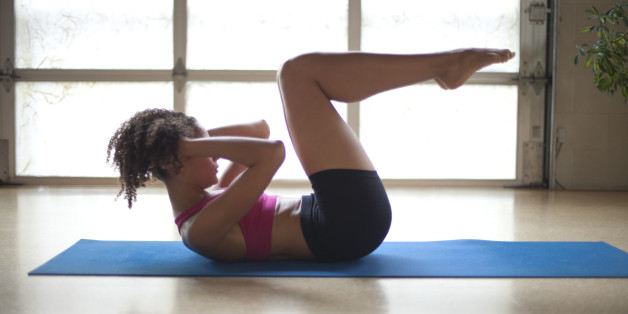Don’t Give Up: 9 tips for sticking with your exercise program (when you would rather just quit)
There are many reasons why exercise programs get dumped before noticeable changes occur. I’ve selected the top 9 reasons you might be tempted to quit, and the best strategies for sticking with it.
A successful fitness plan has many components -- not the least is which: change. Let’s face it -- change is hard, and it takes time! If you’re new to fitness, or starting up again after a long hiatus, you may be tempted to give up before your hard work produces visible improvements. What you may not realize is that changes are taking place. The minute you decide to adopt a healthier lifestyle, change takes place immediately (it is just more mental than physical). And from the very first exercise session, changes occur within the body – you just can’t see them yet. Noticeable improvments take anywhere from 4 to 8 weeks, so stick with it -- the changes you can see are right around the corner.
Need stick-to-it-ed-ness? Follow These 9 Tips!
1) Cardiovascular training is difficult in the beginning.
It is not unusual for the novice exercise feel winded. Stick with it, increase your distance/time/intensity gradually (2-5% per week) and that winded feeling will improve within 6-8 weeks of consistent cardiovascular training.
2) Some muscle soreness should be expected at the onset of your new program.
This should subside after the first 3-4 workouts, whether you’re doing strength or cardiovascular training. You should not experience severe pain, which could indicate injury.
Consult your doctor if:
• Soreness gets worse
• Pain is severe
• You experience joint immobility, swelling, or redness
3) Start slowly and be patient – change takes time.
Do too much too fast, and you risk injury or exhaustion. Start where you are, physically, mentally and emotionally, and build from there.
4) Be consistent!
Physical changes will begin to take place between weeks 4-8. The more consistent you are, the more quickly you’ll notice a difference and the more profound it will be.
5) More is good...to a point.
The signs and symptoms of overtraining are often overlooked or blamed on other causes.
What to look for:
• Feeling tired, drained, lacking energy
• Mild leg soreness, general aches and pains
• Sudden drop in physical performance
• Insomnia
• Headaches
• Suppressed immunity (increased number of colds, sore throats, etc.)
• Irritability and moodiness
• Mild depression
• Lack of interest/loss of enthusiasm for sport you’re training for
• Decreased appetite, or ravenous appetite
• Increased incidence of injuries
• A compulsive need to exercise
Adequate rest/recovery are important components of any training program. Not getting enough down time makes it difficult for your body to fully recover between workouts. The more intense your workout, the more recovery time you need.
If you begin to experience any of these symptoms, it could mean you are overtraining. Take the “less is more” approach and back off of your training schedule by 5-10% until symptoms improve. Get plenty of sleep, drink lots of fluids, and take extra care to see that your diet is nutritionally balanced.
6) Unleash your insecurities.
Think every car that passes you or every patron at the gym is watching you and taking notes? Feeling self-conscious about working out is common. These feelings are most acute at the onset of a fitness program. The solution is to let go of the idea you have to be perfect. Stop putting unnecessary pressure on yourself to perform at unrealistic levels. Instead, focus on what you enjoy about exercise. You’ll get better with each workout session, your confidence will improve and you’ll feel less self-conscious as time goes on.
7) Be consistent.
Do you find yourself canceling your exercise sessions or putting them off until
“later”? Often, “later” never comes. Schedule your workouts just like you schedule any other appointment, and hold that appointment sacred! Remember – change takes a commitment.
8) Let go of “all or nothing” thinking.
That is, thinking that if you don’t have time for your full workout, then doing nothing is
the only alternative. Do something! Exercising at moderate intensity for just 10 minutes
can help maintain fitness gains. That alone is worth the small time commitment.
9) Take it one day at a time.
Rather than view the whole week in its entirety and risk becoming overwhelmed by daily workouts, tracking progress, etc., just focus on today. By briefly eliminating the “big picture,” you can focus all of your energy on daily goals: executing your scheduled workout; making healthy food choices; and maintaining a positive attitude. Why just one day? Twenty-four hours is a timeframe you can easily work within and accomplish something. When you string successful days together into weeks, then months, the work seems effortless and the results will surely be your reward.
About the Author:
Diane Raymond is a noted fitness expert and the founder of
Blue Sky Gym, a personal training business specializing in outdoor and in-home training, group classes, live workshops and health/fitness education.
*This article can be reprinted provided the author bio is included.
-
The Top 7 Ways to get Rid of Stomach Fat
The most effective method to get rid of belly is based on several
-
Lost the Weight? Heres How to Keep It Off
V
-
Im trying to lose weight. Could protein shakes help?
Manufacturers of protein shakes may claim that their products help dec
-
How You Can Benefit from an NYC Nutritionist
Today more than ever, people realize how important of a role nutrit
-
Five Appetite Control Foods That Suppress Cravings
There is a reality about weight loss that people need to be aware of.
-
5 Things You Need To Know About NurtiSystem Food
Many people are attracted to fad diets and meal plans that promise the
- DON'T MISS
- Carlsbad Personal Trainer - Getting A Flat Stomach
- Lose Weight With Hypnosis – Discover The Performance Of That Innovative Approach
- Shifting The Pounds – Ways of Tackle This unique Struggle
- Diet Solution Program - The Ultimate Five Dieting Tips
- But I Don’t Need a Personal Trainer!
- Burn fat now – Do it naturally
- Oil Prices, Our Economy And National Disasters
- Gaining The Weight Back After You Lose It? Secrets To Stop It
- A Positive Approach to Weight Loss
- Fat Burning Workout: The Stair Stepper




